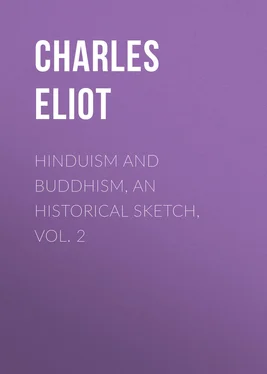About 600 A.D. India was exhausted by her struggle with the Huns. After it there remained only a multitude of small states and obscure dynasties, but there was evidently a readiness to accept any form of unifying and tranquillizing rule and for nearly half a century this was provided by Harsha. He conquered northern India from the Panjab to Bengal but failed to subdue the Deccan. Though a great part of his reign was spent in war, learning and education flourished. Hsüan Chuang, who was his honoured guest, gives a good account of his administration but also makes it plain that brigandage prevailed and that travelling was dangerous.
Конец ознакомительного фрагмента.
Текст предоставлен ООО «ЛитРес».
Прочитайте эту книгу целиком, купив полную легальную версию на ЛитРес.
Безопасно оплатить книгу можно банковской картой Visa, MasterCard, Maestro, со счета мобильного телефона, с платежного терминала, в салоне МТС или Связной, через PayPal, WebMoney, Яндекс.Деньги, QIWI Кошелек, бонусными картами или другим удобным Вам способом.
Sanskrit, Mahâyâna ; Chinese, Ta Ch'êng (pronounced Tai Shêng in many southern provinces); Japanese, Dai-jō Tibetan, Theg-pa-chen-po ; Mongolian, Yäkä-külgän ; Sanskrit, Hînayâna ; Chinese, Hsiao-Ch'êng ; Japanese, Shō-jō Tibetan, Theg-dman ; Mongolian Ütśükän-külgän . In Sanskrit the synonyms agrayâna and uttama-yâna are also found.
Record of Buddhist practices. Transl. Takakusu, 1896, p. 14. Hsüan Chuang seems to have thought that acceptance of the Yogâcâryabhûmi (Nanjio, 1170) was essential for a Mahayanist. See his life, transl. by Beal, p. 39, transl. by Julien, p. 50.
Saddharma-Puṇḍarîka, chap. III. For brevity, I usually cite this work by the title of The Lotus.
The date 58 B.C. has probably few supporters among scholars now, especially after Marshall's discoveries.
In dealing with the Mahayanists, I use the expression Śâkyamuni in preference to Gotama. It is their own title for the teacher and it seems incongruous to use the purely human name of Gotama in describing doctrines which represent him as superhuman.
But Kings Hsin-byu-shin of Burma and Śrî Sûryavaṃsa Râma of Siam have left inscriptions recording their desire to become Buddhas. See my chapters on Burma and Siam below. Mahayanist ideas may easily have entered these countries from China, but even in Ceylon the idea of becoming a Buddha or Bodhisattva is not unknown. See Manual of a Mystic (P.T.S. 1916), pp. xviii and 140.
E.g. in Itivuttakam 75, there is a description of the man who is like a drought and gives nothing, the man who is like rain in a certain district and the man who is Sabbabhûtânukampako, compassionate to all creatures, and like rain falling everywhere. Similarly Ib. 84, and elsewhere, we have descriptions of persons (ordinary disciples as well as Buddhas) who are born for the welfare of gods and men bahujanahitâya, bahujanasukhâya, lokânukampâya, atthâya, hitâya, sukhâya devamanussânam.
Ed. Senart, vol. I. p. 142.
The Bodhicaryâvatâra was edited by Minayeff, 1889 and also in the Journal of the Buddhist Text Society and the Bibliotheca Indica . De la Vallée Poussin published parts of the text and commentary in his Bouddhisme and also a translation in 1907.
The career of the Bodhisattva is also discussed in detail in the Avatamsaka sûtra and in works attributed to Nâgârjuna and Sthiramati, the Lakshaṇa-vimukta-hṛidaya-śâstra and the Mahâyâna-dharma-dhâtvaviśeshata-śâstra. I only know of these works as quoted by Teitaro Suzuki.
See Childers, Pali Dict. s.v. Patti, Pattianuppadânam and Puñño.
It occurs in the Pali Canon, e.g. Itivuttakam 100. Tassa me tumhe puttâ orasâ, mukhato jâtâ, dhammajâ.
See Sylvain Lévi, Mahâyâna-sûtrâlankâra : introduction and passim. For much additional information about the Bhûmis see De la Vallée Poussin's article "Bodhisattva" in E.R.E.
Eminent doctors such as Nâgârjuna and Asanga are often described as Bodhisattvas just as eminent Hindu teachers, e.g. Caitanya, are described as Avatâras.
The idea that Arhats may postpone their entry into Nirvana for the good of the world is not unknown to the Pali Canon. According to the Maha Parin-Sutta the Buddha himself might have done so. Legends which cannot be called definitely Mahayanist relate how Piṇḍola and others are to tarry until Maitreya come and how Kâśyapa in a less active role awaits him in a cave or tomb, ready to revive at his advent. See J.A. 1916, II. pp. 196, 270.
E.g. Lotus, chap. I.
De la Vallée Poussin's article "Avalokita" in E.R.E. may be consulted.
Lotus, S.B.E. XXI. p. 407.
sPyan-ras-gzigs rendered in Mongol by Nidübär-üdzäkci. The other common Mongol name Ariobalo appears to be a corruption of Âryâvalokita.
Meaning apparently the seeing and self-existent one. Cf. Ta-tzǔ-tsai as a name of Śiva.
A maidservant in the drama Mâlatîmâdhava is called Avalokita. It is not clear whether it is a feminine form of the divine name or an adjective meaning looked-at, or admirable.
S.B.E. XXI. pp. 4 and 406 ff. It was translated in Chinese between A.D. 265 and 316 and chap. XXIV was separately translated between A.D. 384 and 417. See Nanjio, Catalogue Nos. 136, 137, 138.
Hsüan Chuang (Watters, II. 215, 224) relates how an Indian sage recited the Sui-hsin dhârani before Kuan-tzǔ-tsai's image for three years.
As will be noticed from time to time in these pages, the sudden appearance of new deities in Indian literature often seems strange. The fact is that until deities are generally recognized, standard works pay no attention to them.
Watters, vol. II. pp. 228 ff. It is said that Potalaka is also mentioned in the Hwa-yen-ching or Avatamsaka sûtra. Tibetan tradition connects it with the Śâkya family. See Csoma de Körös, Tibetan studies reprinted 1912, pp. 32-34.
Just as the Lankâvatâra sûtra purports to have been delivered at Lankapura-samudra-malaya-śikhara rendered in the Chinese translation as "in the city of Lanka on the summit of the Malaya mountain on the border of the sea."
See Foucher, Iconographie bouddhique , 1900, pp. 100, 102.
Varamudra.
Читать дальше












